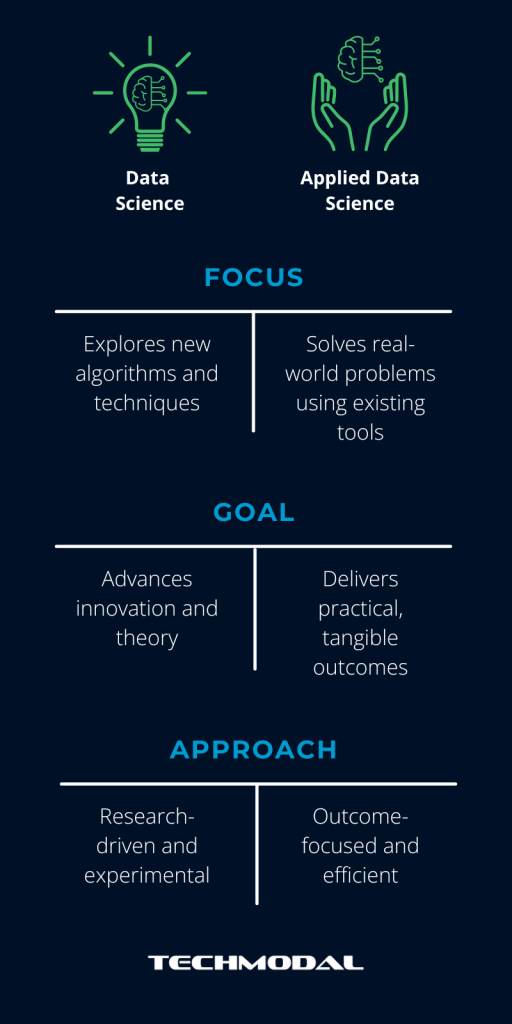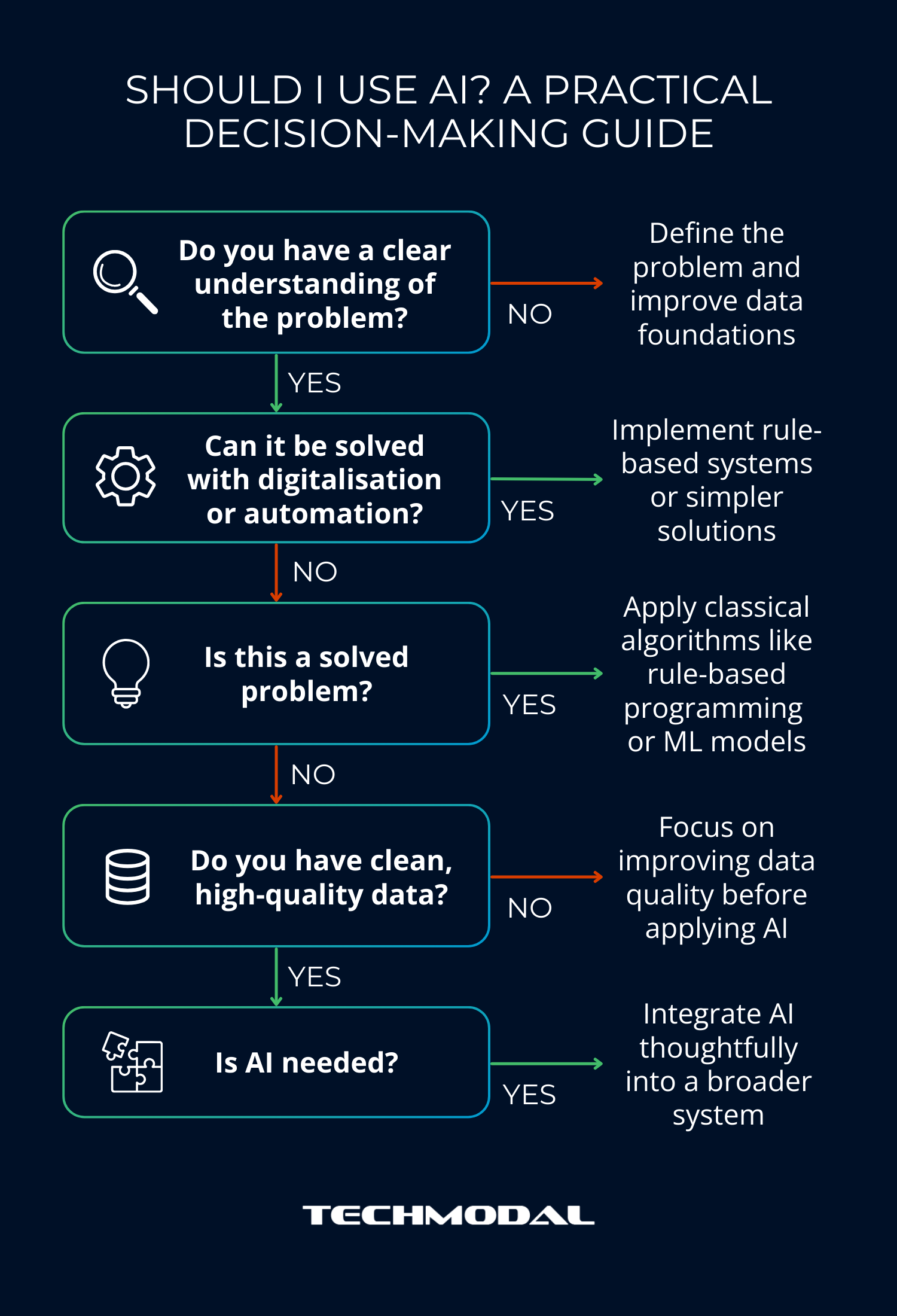
In the last decade, data science has transformed from a niche academic discipline into a mainstream driver of innovation across industries. From finance and defence to healthcare and entertainment; data science is powering a wave of technological advancements. Despite many of the techniques being around since the 70s, such as machine learning (ML) algorithms and statistical models, the technology has only in recent years aligned with the ambition of early AI pioneers.
However, the hype of AI is a double-edged sword. While it’s a powerful tool that can deliver business value if used appropriately, it has wrongly been viewed as the silver bullet to solve all problems even when something simpler, such as a rule-based solution, might do just as well or better. This misconception can lead to misallocated resources and failed projects. The key lies in choosing the right solution and tool to address the problem, a principle that is at the heart of our approach to applied data science.
At its core, data science is about deriving insights from data. However, there’s a significant difference between academic data science and applied data science. The former often focuses on pushing the boundaries on what’s possible, the latter is concerned with solving real-world problems. At Techmodal, we work firmly in the latter space, particularly within the defence and public sectors, where practical outcomes are paramount.
Rather than inventing new algorithms or architectures from scratch, we use industry-standard tools and methodologies to deliver tangible business value. This approach, known as applied data science, prioritises identifying when and where to apply appropriate data science solutions to customer problems.
The goal isn’t to create the next breakthrough in AI research, but to use existing technologies to address customer challenges effectively. By focusing on outcomes rather than methods, we ensure that the solutions we provide are not just theoretically sound but also operationally practical.

"Organisations prioritising data-driven decision-making are significantly more likely to outperform competitors, achieving up to 19 times higher profitability*
Applied data science offers a transformative impact on organisations by converting raw data into actionable insights that drive decision-making, efficiency, and innovation. One of its primary benefits is the ability to improve decision-making processes by uncovering patterns and trends within data, allowing organisations to make more informed and accurate choices.
The application of data science enhances operational efficiency by automating and optimising tasks, which reduces manual labour and minimises errors, leading to increased productivity. This optimisation often results in significant cost savings, as organisations can better allocate resources, predict potential failures, and prevent inefficiencies before they occur. Moreover, applied data science plays a crucial role in risk mitigation, enabling organisations to anticipate and address potential threats through predictive analytics and anomaly detection.
- Improved decision-making - uncovers patterns and trends to inform accurate, data-driven choices.
- Enhanced operational efficiency - automates and optimises tasks, reducing manual effort and minimising errors.
- Cost savings - identifies inefficiencies, predicts potential failures, and allocates resources effectively.
- Risk mitigation - anticipates threats through predictive analytics and anomaly detection.
- Innovation enablement - unlocks new opportunities by transforming raw data into actionable insights.

An all-too-common scenario within defence and the public sector – and indeed, in many industries – is a desire to “apply AI” without a clear understanding of the problem at hand. This top-down approach often starts at the solution and not at the problem, which is a recipe for failure.
The first step in any data science project should be to thoroughly understand the problem and establish strong data foundations before applying any kind of AI. Next, organisations should ask whether the problem can be solved through digitalisation or automation. For example, if a process currently involves manual data entry into an Excel file, then a significant improvement can be achieved by moving to a centralised, shared system with proper data governance. Similarly, if analysis is performed in spreadsheets, transitioning to an online dashboard can enhance both efficiency and decision-making.
By approaching each problem and associated solution as an iterative process, organisations can converge on solutions that meet requirements on time, of the desired quality, and within budget. This iterative approach also helps manage expectations, ensuring stakeholders understand that AI isn’t always the answer – and when it is, it’s often just one part of the solution.
Assuming data is in good shape – accessible, correctly formatted, and of high quality – then selecting an appropriate solution can commence. It can be all too tempting to throw resources at training the latest deep learning models which require expensive compute and GPU resource, but this isn’t always the most effective approach. A simpler solution like linear regression (an approach that predicts based on a data that follows a linear trend) or a rules-based system may achieve nearly the same accuracy at a fraction of the cost.
This is where the importance of clearly defining requirements comes in. By working closely with our customers, we ensure the chosen solution is appropriate for the problem at hand. The first question to ask here is “is this a solved problem?”. Often, a classical solution such as rule-based programming, regular expressions (regex), or clustering algorithms like K-means will suffice. If a more sophisticated solution is needed, off-the-shelf pretrained AI models may be the next step. For example, computer vision tasks, pre-trained models like YOLO (You Only Look Once) or CLIP (Contrastive Language-Image Pretraining) can provide robust performance without the need for extensive retraining. In natural language processing (NLP), open-source large language models (LLMs) such as Mistral, or OpenAI’s GPT-4 can be leveraged to tackle complex language-related tasks.
However, it’s essential to remember that AI will often not make up the full solution, but part of it. For instance, an AI model might be excellent at extracting patterns from data, but the overall system also needs components for data ingestion, preprocessing, decision-making, and user interaction. By integrating AI thoughtfully into a broader solution, businesses can maximise its value without overcomplicating their tech stack.
We have a strong track record of delivering impactful applied data science solutions across many defence disciplines. By using cutting-edge technologies such as reinforcement learning, deep learning, computer vision, large language models (LLMs), semantic search, and retrieval augmented generation (RAG) (plus many more), we have successfully addressed complex challenges with solutions that are directly applicable to other industry sectors.
Enhanced query results for defence.
We enhanced database search capabilities with semantic search techniques, moving beyond simple keyword matching to enable context-aware results. Deployed to multiple cloud platforms, the solution streamlined search processes, delivering faster, more informed reporting for defence clients.
Efficiency gains for data classification
Our automated multi-class text classification solution transformed a time-intensive manual process, saving significant time and reducing errors. This system improved operational efficiency, enhanced data governance, and laid the foundation for future model development in the defence sector.
Innovating with acoustic data
Using deep learning, we converted raw underwater audio into actionable intelligence, improving detection and classification of subsurface contacts. This innovation has significantly enhanced operational decision-making and holds potential applications in energy and environmental monitoring.
Object detection with satellite imagery
By leveraging synthetic data, we developed a robust ship detection system for satellite imagery, overcoming the challenge of limited real-world training data. This solution is adaptable for environmental monitoring and other industries reliant on visual data analysis.
Custom NLP for unique needs
We customised large language models to create a bespoke ChatGPT-like tool that understands and responds to defence-specific language needs. This innovative approach improved client support and can be adapted to meet similar challenges in other industries.
Insights from complex databases
Our exploration of defence databases uncovered unique patterns, enabling improved forecasting models and actionable insights. This project highlighted our adaptability in tackling complex data challenges while maintaining a focus on tangible results.
Working within the public sector presents unique challenges, including strict security protocols, hardware limitations, and specific licensing restrictions. We help our customers navigate these complexities, consistently delivering effective solutions that meet the stringent requirements of their environment. Unlike commercial settings where flexibility is often available, our customer projects often must operate within tightly controlled environments. Our expertise has seen us implement alternative solutions when common open-source or cloud-based tools are restricted due to licensing or security concerns, and we ensure that functionality is never compromised.

Deploying Data Science solutions to air-gapped offline systems, a common scenario in our customer space, adds further complications. We have developed a refined approach to address this, performing development and testing in secure, compliant environments before carefully transitioning the solution to the target system. Our ability to maintain compliance while delivering high-quality results reflects our deep understanding of the sector’s unique demands.
Another common challenge is ensuring that the expectations and solutions requested by clients align with the hardware and software capabilities available. For example, clients may request the implementation of resource-intensive models, such as deep learning algorithms, without realising that the available hardware—such as GPUs—may not support the necessary computation. Careful consideration into the design of systems to overcome this challenge is something that Techmodal excels at.
"Data has the potential to be one of the most powerful assets in today’s organisations—but only when used effectively.By prioritising practical, real-world outcomes, applied data science ensures every insight drives measurable value.
In an era where data is both abundant and powerful, the ability to apply data science effectively is a critical differentiator for organisations, particularly in complex environments. By focusing on real-world application rather than theoretical exploration, organisations can ensure that every application of data science drives tangible business value.
Key to success is the ability to adapt cutting-edge AI technology to create practical, user-friendly solutions. Building expertise in leveraging advanced technologies like reinforcement learning, deep learning, computer vision, and large language models can consistently result in innovative solutions that push the boundaries of what is possible.
Whether it’s improving operational efficiency, automating labour-intensive tasks, or advancing capabilities in data science, our applied approach at Techmodal ensures that AI and data science are not just buzzwords but powerful tools that deliver measurable results. As the field of data science continues to evolve, we remain committed to providing reliable, secure, and effective solutions that meet the unique demands of our clients, ensuring that they stay ahead in an increasingly data-driven world.


